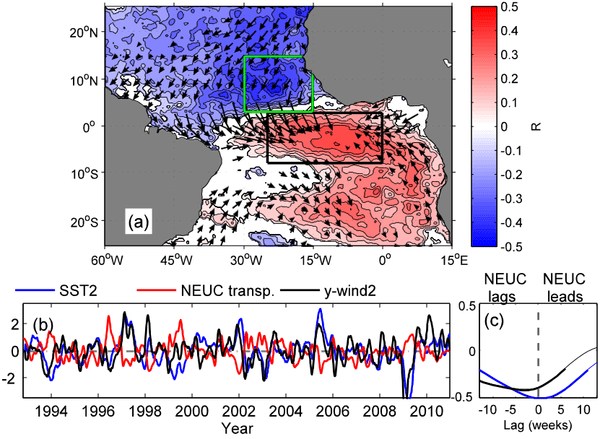by Marlos Goes, Gustavo Goni, Verena Hormann and Renellys Perez
Scientists at PHOD developed a synthetic method, which combines high-density expendable bathythermograph (XBT) temperature data along the AX08 XBT transect (which runs between Cape Town and NYC) with altimetric sea level anomalies, to estimate the variability of the off-equatorial currents, such as the North Equatorial Countercurrent and the North Equatorial Undercurrent, on seasonal to interannual timescales. Understanding how the ocean dynamics is liked to anomalies of temperature and wind-stress in the tropical Atlantic is critical to understand the climate and weather variability in the adjacent continental areas.
The upper-ocean zonal current system in the tropical Atlantic is of great importance for both interhemispheric and west-to-east exchange of heat, salt and nutrients. Here a synthetic method has been developed, validated, and applied to monitor the off-equatorial eastward currents in the central tropical Atlantic. This method combines high-density expendable bathythermograph (XBT) temperature data along the AX08 XBT transect (which runs between Cape Town and NYC) with altimetric sea level anomalies (SLAs) to estimate dynamic height fields from which the mean properties of the eastward currents and their variability can be estimated on seasonal to interannual timescales. Estimates of the seasonal variability associated with the surface North Equatorial Countercurrent (NECC), and subsurface North Equatorial Undercurrent (NEUC) and South Equatorial Undercurrent (SEUC) that result from the synthetic method improve considerably upon estimates based solely on climatological data. A positive correlation is found between interannual variations of the NECC transport and two indices based on an interhemispheric sea surface temperature (SST) gradient and southeasterly winds in the central tropical Atlantic. The NEUC is correlated on interannual timescales with SSTs and meridional winds in the Gulf of Guinea and zonal equatorial wind stress. This study highlights the value of multiplatform observations for understanding how the ocean dynamics is liked to anomalies of SST and wind-stress in the tropical Atlantic, which are regulators of regional climate and weather variability.

Goes, M., G. Goni, V. Hormann, R. Perez, 2013. Variability of the Atlantic off-equatorial eastward currents during 1993-2010 using a synthetic method. Accepted at J. Geophys. Res.-Oceans.